
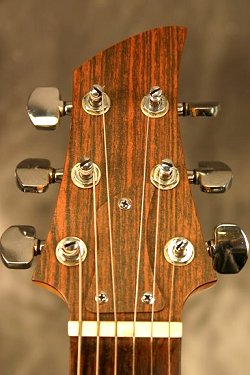
|
Other alterations soon took place to the headstock as well. But as Matt Umanov states "The lower portion of the
peghead was already wide, and the tuning pegs already mostly in line with the nut slots, although that was not my
intention; I was thinking more in the realm or esthetics.. At that point, Danny may have lined the tuners up a little
more closely (but not much) with the nut slots, maybe he got a brainstorm on the spot."
The new headstock also brought the tuners closer together vertically, which made for a minimum of string tension
difference between strings. Altogether, the changes made for a radically new styled headstock with its new looks only
being surpassed by its functionality.
|
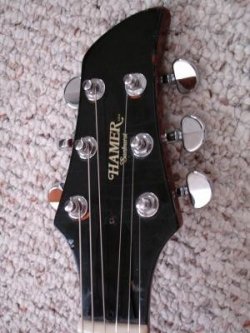
|
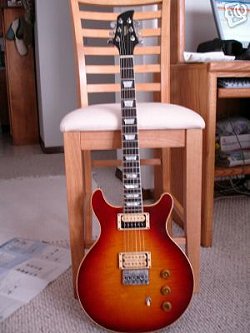
|
Ironically, it would not be Dan that would have to worry about a lawsuit over a headstock design - but as can be seen above left and right, it's
surprising that Dan didn't take issue with Hamer over some of their instruments. Probably because only two such instruments were
produced in 1978 & 79. They were custom built for the guitarists in the British rock band Rockpile.
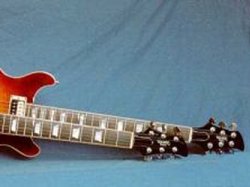
|
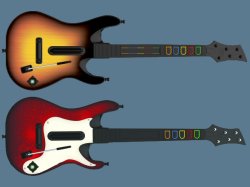
|
Above left, both of the Hamer instruments made for Billy Bremner & Dave Edmunds of Rockpile. It is unknown why they both requested to have
Dan Armstrong styled headstocks on them. At upper right, even Guitar Hero models sport the Armstrong style headstock.
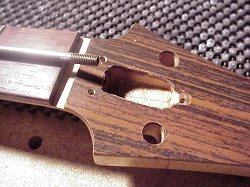
|
The maple neck features an adjustable steel truss rod
to reinforce itself by counteracting the pressure of the string pull, which in turn helps to keep the neck straight.
Bill Richardson goes on to say more. "Dan knew that many of his customers were greatly over-tightening the truss
rods on their guitar necks in order to get better string action, and he knew of the inherent danger of over tightening
the rod. So when it came time to design his own instruments, he built both the necks and fingerboards out of
quarter-sawn woods instead of the more available slab woods that is commonly used in the industry."
Photo courtesy of Bill Richardson.
|
Bill continues, stating "The biggest misconception players have is that truss rods are for adjusting action. While adjusting the
truss rod does indeed affect the playing action, that's a side effect and not the purpose for the adjustment. The
sole purpose of the truss rod is to straighten the neck, and while quarter-sawn wood was more expensive, the neck is
much stronger, much less likely to ever twist or warp and the pressure of the truss rod to keep the neck straight is
greatly reduced, perhaps by as much as 40% in some cases. Dan knew all this, and he said that he didn't want his necks
coming back in for repairs later on down the road so he used quarter-sawn woods throughout their years of production."
As seen above, luthier Bill Richardson works on a Dan Armstrong bass guitar that it's new owner had purchased and had
brought in to his shop for just such a repair. Apparently its past owner had kept tightening the truss rod instead of
making bridge height adjustments or placing a shim underneath the base of the neck to slightly change the angle of the
neck. As a result, the truss rod was tightened to the point that it broke. Bill goes on to say "on this bass the
truss rod was broken so the only thing to be done was to replace it. The only problem is that the past owner, in
addition to busting the truss rod, had used epoxy to glue the busted rod in what would be its final resting position."
The photo above shows the replacement truss rod "ready to install, but first I had to dig out the old glue and remove a
tiny bit of the formica just under the top truss rod cover screw to pull the old truss rod out. Then I tapped a new
one (like Dan told me) and rebuilt a new ivory nut for the customer and we were on our way to a killer bass again."
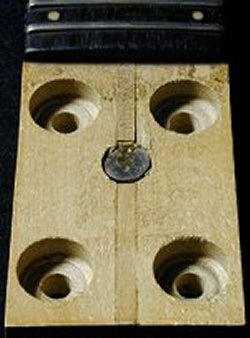
|
There really isn't a body heel, but a small change in the neck shape just prior to it getting squared off in order for it to fit into
the machined cavity of the acrylic body. The rosewood fingerboard rises above the maple neck by approx. ¼" at the center,
moving down to approx. half as much at the edges due to the 9.5° radius of the fingerboard itself.
Matt Umanov designed the tongue when building the necks for the prototypes, and describes it's origin stating "It's exactly the Les Paul design of neck
attachment, maybe with a slightly longer tongue, to accommodate bolts rather than glue." When it was completed, the 33/8" maple
tongue extends deep into the body, and bolts down right next to the pickup which helps, not only the sustain, but also the structural rigidity of the neck to body joint.
The Dan Armstrong guitar was not the first instrument to feature a deep-set bolt-on neck,
as Mosrite had such a neck on their mid-60's Ventura Mark V
and other similar guitars in the early 1960's.
|
As such, the neck is a front bolt on design that fastens to the body using four ½"
carriage bolts, and when secured in place, the maple tongue rests flush with the top of the acrylic body with the
fingerboard elevated slightly above it, which in turn allows access to all 24 frets. The two octave neck, though rare for its time was not a first. For
example, the 1961 Burns-Vibra model has a 24 fret neck. Since the tongue resides underneath
the guitars' scratchplate the tongue features four partially recessed holes, larger in size than the holes for the ½" bolts, which allow the washers and
nuts for the aforementioned bolts to reside in and tighten the neck to the body.
The tongue of the neck is also where the end piece of the adjustable truss rod can seen. As seen above,
notice the maple filler strips that are glued in afterwards. The truss rod screws into this end piece and so is
replaceable (if ever need be). The new truss rod has to be inserted from the guitars headstock as seen at the top of
this page.
The tongue sometimes features a letter, or letters that are stamped into the base, or bottom and it's most
unfortunate that Dan had passed away before I could ask him about these unusual markings, but I can't help but believe that
even he might not have had an answer as to what they were, or what they represented.
At upper left, one of my own necks - a very early 1969 model reveals the letter A stamped upside down
at the base of the tongue. At upper right, another model reveals the letter G also stamped upside
down at the base of the tongue. Notice how the tongue is not even drilled out for bolts to attach it to the body.
My best working theory was that perhaps only the earliest models featured these stamped in markings, though I still
didn't know why - but as can be seen at upper left, and with a serial number of D1025A - the tongue on this bass neck
has the letters G V stamped into it and is one of the first ever seen with two such letters. Like the
others however, these letters are stamped upside down (relative to the serial number and the rest of the neck) and is
more centered than the others which are stamped more toward one side.
At upper right, another very early model bass which can be seen more in the bass section. This one is such an early
model that its serial number is stamped into the base of the neck, rather than on the side like most. Notice how the
neck bolts do not have a machined end, but rather have been cut down (more about it in the hardware section). The
serial number of this neck D150A relates to around the 50th model to have left the actual production line
as Dan long ago told me that the first 100 were experimental models. Notice the larger letter A that
is stamped in just to the right of the serial number. This one is also unusual in that this letter is stamped in
right-side up. Given such an early serial number, and, coupled with my own neck which was the 104th model
to have left the production line and you can see where I developed my theory from. However, and as seen back at left,
the serial number D1025A corresponds to the 925th model off the production line, which tends to shoot
holes in this theory.
My next theory was that perhaps it was a stamp from a quality assurance technician stating the neck was checked over
in the early stages before it went any further as the one photo above right reveals the tongue with a stamped in
letter, yet no holes drilled yet for the neck bolts. Building on this theory I then thought perhaps in the earliest
days a tech with the first, or last initial A was stamping these while later on a tech with the
initials G and G V (first & last initials) may have been the tech. But this same
photo reveals a totally finished neck with frets and all, only the bolt holes have not been drilled. Also, if it was a
case of a quality technician stamp, why would so many necks not have a stamp at all? Lastly, and as can be read only
two pages back, Mr. Steve Constantelos, one of Ampegs engineers had told me that the guitar necks for the Dan
Armstrong instruments were under the supervision of Pete 'Buddy' Tuscano - who was a wood specialist as well as
manager of the instrument division and who involved himself in everything from the grade of wood coming into the
factory to the final finishing touches before the instrument shipped - meaning that if anyones initials should be on
there, it should be his. So much for theory number two.
Despite my best efforts to make sense of it, about all I can report to date is that I've noticed the earlier serial
numbers tend to feature the letter A while later models seem to have the letters G
and GV stamped into them. Most Dan Armstrong · Ampeg instruments do not have
these additional letters stamped into the neck tongues, but as seen here a small handful of them do. Unless more
information is forthcoming in the future, it seems likely that this will forever remain a Dan Armstrong guitar mystery.
continue
menu
Names and images are TMand © Dan Armstrong / Ampeg. All rights reserved.
All other names and images are TMand © of their respective owners. All rights reserved.
|
| |

